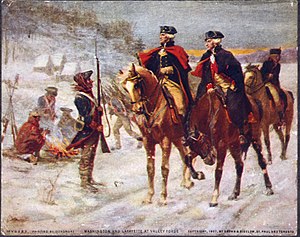
Back Velli-Forc Azerbaijani Valley Forge German Valley Forge Spanish دره فورج Persian Valley Forge French Valley Forge Italian バレーフォージ Japanese 밸리 포지 Korean व्हॅली फोर्ज Marathi Valley Forge Dutch
| Valley Forge | |||||
|---|---|---|---|---|---|
| Part of the American Revolution | |||||
 A 1907 portrait of Washington and Lafayette at Valley Forge by John Ward Dunsmore | |||||
| |||||
Valley Forge was the winter encampment of the Continental Army, under the command of George Washington, during the American Revolutionary War. The Valley Forge encampment lasted six months, from December 19, 1777, to June 19, 1778. It was the third of the eight winter encampments that Washington and the Continental Army endured during the war.
Three months prior to the encampment at Valley Forge, in September 1777, the Second Continental Congress was forced to flee the revolutionary capital of Philadelphia ahead of an imminent British attack on the city following Washington's defeat in the Battle of Brandywine, a key battle during the British Army's Philadelphia campaign. Unable to defend Philadelphia, Washington led his 12,000-man army into winter quarters at Valley Forge, located approximately 18 miles (29 km) northwest of Philadelphia.[1][2][3]
At Valley Forge, the Continental Army struggled to manage a disastrous supply crisis while simultaneously retraining and reorganizing their units in an effort to mount successful counterattacks against the British. During the encampment at Valley Forge, an estimated 1,700 to 2,000 soldiers died from disease, possibly exacerbated by malnutrition and cold, wet weather. In 1976, in recognition of the enormous historical significance of Valley Forge in American history, Valley Forge National Historical Park was established and named a national historic site, which protects and preserves nearly 3,500 acres of the original Valley Forge encampment site. The park is a popular tourist destination, drawing nearly 2 million visitors each year.[4][5]
- ^ Program, National Park Service Museum Management; Joan, Bacharach; Bassim, Khaled; Joni, Rowe (August 19, 2002). "'American Revolutionary War: Valley Forge National Historical Park Museum Collections". www.nps.gov. Retrieved February 23, 2018.
- ^ Martin, James Kirby; Lender, Mark Edward (June 2, 2015). A Respectable Army: The Military Origins of the Republic, 1763–1789. John Wiley & Sons. ISBN 9781118923887.
- ^ "Timeline of the American Revolution 1763 - 1783" (PDF). Retrieved February 23, 2018.
- ^ Valley Forge National Historical Park, General Management Plan: Environmental Impact Statement. 2007.
- ^ "NPS Annual Recreation Visits Report". National Park Service. Retrieved October 6, 2012.